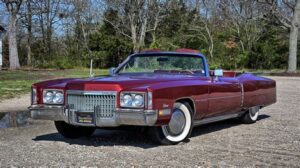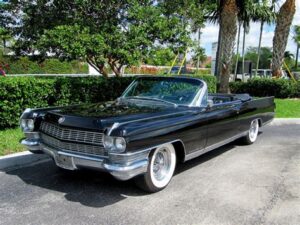Introducing the 1970 Cadillac Convertible DeVille, a cherished classic that embodies elegance and sophistication. Renowned for its stunning design and robust performance, this iconic vehicle has left an indelible mark on the hearts of classic car enthusiasts. With its striking lines, luxurious interior, and transformative power under the hood, the 1970 Cadillac Convertible DeVille is not just a mode of transportation; it’s a symbol of status and artistry. In this article, we’ll explore its design features, performance specifications, and essential restoration tips, providing insights to help you appreciate this gem of automotive history. Additionally, we’ll discuss how to maintain the value of your investment and engage with the passionate community of Cadillac aficionados. Get ready to dive into the world of classic luxury and discover what makes the 1970 Cadillac Convertible DeVille a timeless treasure.
Exploring The Design Features Of The 1970 Cadillac Convertible DeVille
The 1970 Cadillac Convertible DeVille stands as a timeless emblem of luxury and style. With its distinctive design elements, this classic car captures the essence of the era’s automotive aesthetics. Here, we delve into the iconic design features that make the 1970 Cadillac Convertible DeVille a standout classic.
One of the most striking aspects of the 1970 Cadillac is its expansive body. Measuring about 17 feet in length, the sleek silhouette exudes an imposing yet elegant presence on the road. The long hood and short deck proportions contribute to its classic American muscle appearance, making it instantly recognizable.
Another notable feature is the front grille, which is adorned with sleek chrome accents and distinctive vertical slats. This grill not only enhances the vehicle’s elegance but also improves airflow to the engine. Coupled with the prominent Cadillac crest, it embodies the luxury associated with the brand.
The 1970 model also features pronounced fenders and sweeping lines that flow gracefully from front to rear. The sculpted curves create a sense of motion, even when the vehicle is stationary. Additionally, the rear end is characterized by its bold tailfins—synonymous with Cadillac design—emphasizing a vintage aesthetic that enthusiasts adore.
Inside, the cabin reflects the luxury that Cadillac is renowned for. High-quality materials such as leather upholstery, plush seating, and elegant trim are abundant. The dashboard is designed with driver comfort in mind, providing intuitive access to controls and instrumentation. Ambient lighting and thoughtful ergonomic designs further enhance the luxurious feel of the interior.
The design features of the 1970 Cadillac Convertible DeVille not only exemplify a high level of craftsmanship but also contribute to its status as a collector’s piece today. This combination of elegance, style, and vintage charm continues to attract classic car enthusiasts and showcases Cadillac’s dedication to design excellence during this iconic period.
Understanding The Performance Specifications Of The 1970 Cadillac
The 1970 Cadillac Convertible DeVille is celebrated not only for its luxurious design but also for its impressive performance specifications that define the classic American automotive experience. Let’s delve deeper into the engine options, transmission, and overall performance metrics that make this model stand out.
The 1970 Cadillac Convertible DeVille was equipped with a powerful 472 cubic inch V8 engine that produced a robust 375 horsepower. This engine was designed to provide an exceptional driving experience, enabling the Cadillac to deliver strong acceleration and smooth operation. The torque output was equally impressive, peaking at 525 lb-ft, which contributed to the car’s substantial performance alongside its weight, approximating around 5,000 lbs.
To complement its potent engine, the 1970 Cadillac featured a Turbine Drive automatic transmission with variable pitch. This transmission offered a refined driving experience, providing smooth shifts and a seamless connection between the engine and wheels. It allowed for high levels of torque to be utilized, enhancing acceleration without sacrificing comfort.
The handling of the 1970 Cadillac was well-engineered, featuring a front independent suspension system and a rear coil spring suspension. This combination offered a smooth ride while maintaining stability at speed. While not designed for sporty handling, the Cadillac’s suspension system allowed it to glide over rough pavement with grace, emphasizing comfort over cornering prowess.
Additionally, stopping power came from front disc brakes and rear drum brakes, a standard setup for cars of this era. Although it may not compare to modern braking systems, the combination of size and technology provided adequate stopping performance for the time.
Overall, the performance specifications of the 1970 Cadillac Convertible DeVille exemplified the blend of power, comfort, and luxury that Cadillac is renowned for. With its commanding presence on the road and a driving experience that feels both potent and refined, this model continues to capture the admiration of classic car enthusiasts.
Restoration Tips For The 1970 Cadillac Convertible DeVille
The restoration of a 1970 Cadillac Convertible DeVille is an exciting yet challenging endeavor that requires careful planning and attention to detail. Here are some essential tips to help you successfully restore this classic vehicle:
- Research Thoroughly: Before starting your restoration project, it’s crucial to gather as much information as possible about the 1970 Cadillac. Join online forums, read restoration guides, and network with other classic car enthusiasts to understand common issues and restoration techniques.
- Create a Restoration Plan: Outline a step-by-step plan for your restoration process. This should include the budget, timeline, and the specific areas of the car you want to focus on (interior, exterior, engine, etc.). A detailed plan will help keep your project organized.
- Assess the Condition: Perform a thorough inspection of the vehicle to identify areas that need replacement or repair. Pay close attention to rust, frame condition, and engine components, as these are critical for safety and performance.
- Source Quality Parts: Look for OEM parts or high-quality aftermarket parts to ensure authenticity and longevity. Websites specializing in classic car parts or local salvage yards can be excellent resources.
- Document Your Progress: Keep a detailed log of your restoration journey, including before-and-after photos, receipts for parts, and notes on the work done. This documentation can enhance the car’s value and appeal when you decide to sell it.
- Engage Professionals When Needed: While DIY is a rewarding approach, some aspects of restoration, such as bodywork and engine rebuilds, may require expertise. Don’t hesitate to hire professionals for jobs beyond your capability.
- Join Local Car Clubs: Connecting with local Cadillac clubs or classic car groups can provide you with invaluable support, resources, and camaraderie throughout your restoration journey.
- Stay Patient and Flexible: Restorations can often take longer and cost more than initially planned. Be prepared for challenges and adjust your plans as necessary, but don’t lose sight of the end goal.
Restoring a 1970 Cadillac Convertible DeVille is about enjoying the process and celebrating the car’s rich history while bringing it back to its former glory.
The Impact Of The 1970 Cadillac On Classic Car Enthusiasts
The 1970 Cadillac Convertible DeVille holds a significant place in the hearts of classic car enthusiasts, thanks to its unique combination of luxury, design, and power. The impact of this model reaches far beyond its production years, influencing car culture and the classic car market in various ways.
First and foremost, the 1970 Cadillac remains a symbol of American automotive excellence. Its iconic styling, characterized by bold lines and an imposing presence, appeals to collectors and restorers alike. Many enthusiasts appreciate the craftsmanship and the attention to detail that Cadillac was known for during this era, making it a desirable addition to any classic car collection.
Furthermore, the performance specifications and technological innovations present in the 1970 Cadillac continue to intrigue enthusiasts. Features such as its powerful V8 engine and advanced (for the time) suspension contribute to an engaging driving experience that classic car lovers cherish. This model represents a time when cars were designed for comfort and prestige, not just speed and efficiency.
The 1970 Cadillac has also fostered a vibrant community among classic car enthusiasts. Car clubs, online forums, and social media groups have sprung up where collectors share restoration tips, advice on maintenance, and personal experiences. These platforms foster a sense of camaraderie among owners, allowing them to connect over their shared admiration for this timeless vehicle.
In addition to community engagement, the 1970 Cadillac Convertible DeVille has seen a resurgence in popularity at classic car shows and auctions. Its rarity and timeless appeal have driven up its value, making it a coveted item among collectors. This increased interest not only benefits individual owners but also supports the broader classic car market.
The impact of the 1970 Cadillac on classic car enthusiasts is undeniable. Its blend of elegance, performance, and cultural significance ensures that this iconic model will remain highly regarded for years to come. As enthusiasts continue to appreciate and restore these remarkable vehicles, the legacy of the 1970 Cadillac will live on in the hearts of car lovers worldwide.
How To Maintain The Value Of Your 1970 Cadillac Convertible DeVille
Maintaining the value of your 1970 Cadillac Convertible DeVille requires a combination of care, preservation, and strategic enhancements. Here are some essential tips to help you keep your classic car in top condition and retain its value:
By following these tips, you can significantly maintain and even enhance the value of your 1970 Cadillac Convertible DeVille, ensuring it remains a prized possession for years to come.
Frequently Asked Questions
What are the key features of the 1970 Cadillac Convertible DeVille?
The 1970 Cadillac Convertible DeVille features a powerful 472 cubic inch V8 engine, luxurious interior with leather seating, power windows, air conditioning, and a distinctive long hood and short deck design characteristic of Cadillac models from that era.
How does the performance of the 1970 Cadillac Convertible DeVille compare to modern cars?
While the 1970 Cadillac Convertible DeVille offers a smooth and powerful ride due to its large V8 engine, its performance metrics like horsepower and fuel efficiency generally fall short compared to modern cars that benefit from advanced engineering and technology.
What is the significance of the 1970 model year for the Cadillac DeVille series?
The 1970 model year is significant because it marked one of the last true full-size Cadillac convertibles before the decline in popularity of such models. It also came with updated styling and luxury features that reinforced Cadillac’s reputation for elegance and comfort.
What maintenance should be considered for a 1970 Cadillac Convertible DeVille?
Routine maintenance for a 1970 Cadillac Convertible DeVille includes regular oil changes, checking and maintaining the electrical system, inspecting the brakes, and ensuring that the convertible top mechanism is functioning properly, as older vehicles can face unique wear and tear.
Is the 1970 Cadillac Convertible DeVille a good investment for classic car enthusiasts?
Yes, the 1970 Cadillac Convertible DeVille is considered a good investment for classic car enthusiasts, especially if it is well-preserved. Its iconic styling, brand heritage, and limited production numbers make it a desirable model among collectors.
What should buyers look for when purchasing a 1970 Cadillac Convertible DeVille?
When purchasing a 1970 Cadillac Convertible DeVille, buyers should look for signs of rust, condition of the convertible top, the functionality of electrical components, the overall condition of the engine and transmission, and whether it has been well-maintained or restored.
What are some popular modifications for the 1970 Cadillac Convertible DeVille?
Popular modifications for the 1970 Cadillac Convertible DeVille include upgrading the sound system, enhancing the suspension for better handling, custom paint jobs, and adding modern safety features while still preserving the vintage charm of the vehicle.





